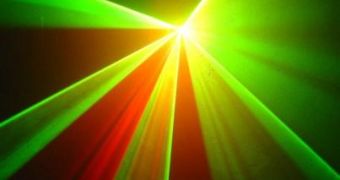We're all used to the red laser, mostly from electronic appliances like DVD players and bar-code scanners, or from movies, where there's always a good guy breaking through a network of red lasers with a can of spray or smoke.
By using a new type of semiconductor, researchers aim to produce more colorful laser light much easier and cheaper than before. The new materials are engineered crystalline semiconductor specks, which brings the tiny flakes, called nanocrystals, a crucial step closer to altering a laser's color just by changing the size of the crystal, which could lead to more powerful applications for detecting chemicals or sending information via flickers of light.
A specific laser color depends on the material used to emit light, as each semiconductor offers the electrons two possible energy states. The band gap, meaning the difference between the two states, determines the color of the emitted light.
"In nanocrystals, the gap changes with their size-the smaller the size, the larger the gap," says physicist Victor Klimov of Los Alamos National Laboratory in New Mexico.
The team of scientists led by Klimov managed to get the nanocrystal's electrons to cooperate by splitting the nanocrystal into a cadmium sulfide core and a zinc selenide shell. The core trapped excited electrons for two nanoseconds, which is 50 times longer than normal and long enough to be hit by an outside photon.
By not needing their own superpowerful laser to get nanocrystals going, such two-layer crystals are long lasting and efficient enough to be melded with electronics, which could lead to a complete array of applications, cheaper, more efficient and versatile compared with present lasers.
Chemical sensors or optical communications devices capable of rapidly switching between laser colors are a good example of what this new technology could bring to the commercial devices.

 14 DAY TRIAL //
14 DAY TRIAL //